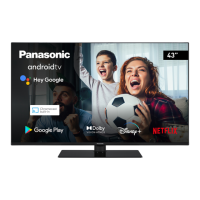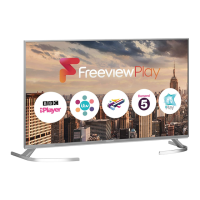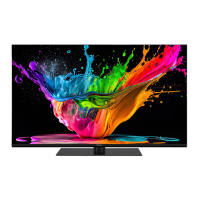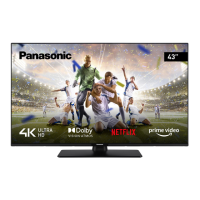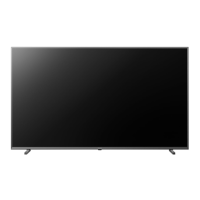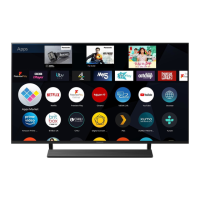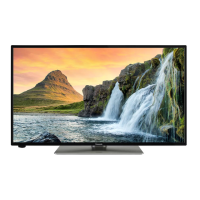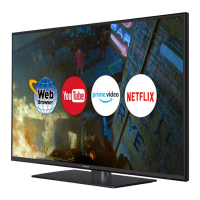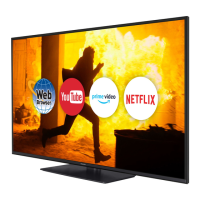Do you have a question about the Panasonic TX-48MZ800B and is the answer not in the manual?
Instructions for accessing the TV's digital manual via settings or remote control.
Key warnings for safe operation, installation, and handling to prevent hazards.
Guidelines for connecting to power, electrical safety, and plug handling.
Explanation of symbols used on the TV for safety and instructional purposes.
Information on Class II equipment, hazardous terminals, and Class 1 laser product warnings.
Precautions to prevent TV tipping and instructions for secure wall mounting.
Procedures for cleaning the display panel, cabinet, and pedestal safely.
Guidance on maintaining the power plug for safe operation.
Step-by-step instructions for attaching and detaching the TV stand.
Information on VESA mounting holes and necessary screw specifications.
A welcome message and a list of items provided with the TV.
Overview of UHD, HDR, HLG, and Dolby Vision capabilities.
Details on automatic and manual OLED panel maintenance procedures.
Explanation of Pixel Shift and Screen Saver to prevent image sticking.
Connecting antenna and power, and managing TV power states.
Guide to various input/output connectors and required cables.
How to operate the TV using the physical joystick and the remote control.
A detailed guide to each button and its function on the remote control.
Instructions for installing batteries and pairing the remote control with the TV.
Step-by-step instructions for the initial TV setup and channel installation.
Configuring Google services, network connection, and privacy settings.
Procedures for setting up channels via Antenna, Cable, or Satellite.
How to navigate the Home Screen and access the Live TV menu.
Methods to access channel lists and TV options menus.
Adjusting picture quality, audio, and setting timers for TV operation.
Settings for HbbTV services and subtitle display preferences.
Connecting to and managing Wi-Fi or Ethernet network settings.
Scanning and managing channels received via antenna.
Procedures for scanning, editing, and managing cable channels.
Detailed steps for satellite scanning, tuning, and list management.
Setting up installation modes, managing apps, and implementing parental controls.
Managing installed apps and configuring device-specific settings.
Configuring TV's date, time, power timers, and input source settings.
Selecting picture modes and adjusting display-related settings.
Fine-tuning picture with DNR, MPEG NR, HDR, and game/PC modes.
Adjusting colour, white balance, and performing OLED panel maintenance.
Configuring sound styles, balance, surround, and Dolby audio processing.
Adjusting Dolby Atmos features, dialogue enhancement, and volume levels.
Settings for visually impaired users, text-to-speech, and caption configuration.
Pairing Bluetooth accessories and managing the channel list.
Using the EPG to browse schedules and search for programs.
Accessing on-demand content and catch-up services via Freeview Play.
Instructions for connecting the TV to the internet using Ethernet or Wi-Fi.
Using the MMP to play various media files and manage content.
Detailed controls for video, music, photo playback, and slideshow settings.
Important considerations for USB devices and enabling auto play feature.
How to record programs and use the timeshift feature.
Formatting USB drives and managing recording/reminder schedules.
Enabling and using HDMI CEC to control connected devices.
Casting content from devices and using HbbTV interactive services.
Connecting to and agreeing to terms for Freeview Play services.
How to check for and install software updates via the internet.
Solutions for common problems like no picture, no sound, or remote issues.
Table detailing compatible resolutions and refresh rates for HDMI inputs.
List of supported video codecs, resolutions, bit rates, and containers.
Details on supported audio codecs, sample rates, and container formats.
List of supported resolutions for various image file types.
Supported subtitle file extensions and parsing methods.
Table showing compatible resolutions when using a DVI converter cable.
Specifications including broadcasting, power, dimensions, and operating environment.
Details on wireless LAN standards, output power, and country-specific restrictions.
Information on DVB services and IPTV compatibility.
Details on licences for technologies like HDMI, Dolby, Google, and Microsoft.
Guidance on proper disposal of electronics and batteries, and DoC information.
Contact details and website for customer support and accessory orders.
Critical instructions for safely connecting the TV to the mains power supply.
Instructions for accessing the TV's digital manual via settings or remote control.
Key warnings for safe operation, installation, and handling to prevent hazards.
Guidelines for connecting to power, electrical safety, and plug handling.
Explanation of symbols used on the TV for safety and instructional purposes.
Information on Class II equipment, hazardous terminals, and Class 1 laser product warnings.
Precautions to prevent TV tipping and instructions for secure wall mounting.
Procedures for cleaning the display panel, cabinet, and pedestal safely.
Guidance on maintaining the power plug for safe operation.
Step-by-step instructions for attaching and detaching the TV stand.
Information on VESA mounting holes and necessary screw specifications.
A welcome message and a list of items provided with the TV.
Overview of UHD, HDR, HLG, and Dolby Vision capabilities.
Details on automatic and manual OLED panel maintenance procedures.
Explanation of Pixel Shift and Screen Saver to prevent image sticking.
Connecting antenna and power, and managing TV power states.
Guide to various input/output connectors and required cables.
How to operate the TV using the physical joystick and the remote control.
A detailed guide to each button and its function on the remote control.
Instructions for installing batteries and pairing the remote control with the TV.
Step-by-step instructions for the initial TV setup and channel installation.
Configuring Google services, network connection, and privacy settings.
Procedures for setting up channels via Antenna, Cable, or Satellite.
How to navigate the Home Screen and access the Live TV menu.
Methods to access channel lists and TV options menus.
Adjusting picture quality, audio, and setting timers for TV operation.
Settings for HbbTV services and subtitle display preferences.
Connecting to and managing Wi-Fi or Ethernet network settings.
Scanning and managing channels received via antenna.
Procedures for scanning, editing, and managing cable channels.
Detailed steps for satellite scanning, tuning, and list management.
Setting up installation modes, managing apps, and implementing parental controls.
Managing installed apps and configuring device-specific settings.
Configuring TV's date, time, power timers, and input source settings.
Selecting picture modes and adjusting display-related settings.
Fine-tuning picture with DNR, MPEG NR, HDR, and game/PC modes.
Adjusting colour, white balance, and performing OLED panel maintenance.
Configuring sound styles, balance, surround, and Dolby audio processing.
Adjusting Dolby Atmos features, dialogue enhancement, and volume levels.
Settings for visually impaired users, text-to-speech, and caption configuration.
Pairing Bluetooth accessories and managing the channel list.
Using the EPG to browse schedules and search for programs.
Accessing on-demand content and catch-up services via Freeview Play.
Instructions for connecting the TV to the internet using Ethernet or Wi-Fi.
Using the MMP to play various media files and manage content.
Detailed controls for video, music, photo playback, and slideshow settings.
Important considerations for USB devices and enabling auto play feature.
How to record programs and use the timeshift feature.
Formatting USB drives and managing recording/reminder schedules.
Enabling and using HDMI CEC to control connected devices.
Casting content from devices and using HbbTV interactive services.
Connecting to and agreeing to terms for Freeview Play services.
How to check for and install software updates via the internet.
Solutions for common problems like no picture, no sound, or remote issues.
Table detailing compatible resolutions and refresh rates for HDMI inputs.
List of supported video codecs, resolutions, bit rates, and containers.
Details on supported audio codecs, sample rates, and container formats.
List of supported resolutions for various image file types.
Supported subtitle file extensions and parsing methods.
Table showing compatible resolutions when using a DVI converter cable.
Specifications including broadcasting, power, dimensions, and operating environment.
Details on wireless LAN standards, output power, and country-specific restrictions.
Information on DVB services and IPTV compatibility.
Details on licences for technologies like HDMI, Dolby, Google, and Microsoft.
Guidance on proper disposal of electronics and batteries, and DoC information.
Contact details and website for customer support and accessory orders.
Critical instructions for safely connecting the TV to the mains power supply.
| Screen shape | Flat |
|---|---|
| Response time | - ms |
| Display diagonal | 48 \ |
| Display brightness | - cd/m² |
| Display technology | OLED |
| Native aspect ratio | 16:9 |
| Contrast ratio (typical) | - |
| Display diagonal (metric) | 121 cm |
| Screen format adjustments | 4:3, 16:9, Zoom |
| Motion interpolation technology | Smooth Motion Drive Pro |
| Dynamic contrast ratio marketing name | Ultimate Contrast |
| Tuner type | Analog & digital |
| Digital signal format system | DVB-C, DVB-S, DVB-S2, DVB-T, DVB-T2 |
| Smart modes | Cinema, Dolby Vision, Dynamic, Game, Normal, Sports, True Cinema |
| Operating system version | 11 |
| App distribution platform | Google Play |
| Operating system installed | Android |
| Hybrid Broadcast Broadband TV (HbbTV) version | 2.0.2 |
| Sound modes | Custom, Game, Movie, Music, News, Sports, Standard |
| Audio decoders | Dolby Atmos, Dolby Digital DTS |
| RMS rated power | 20 W |
| Number of speakers | 2 |
| Stand type | Center stand |
| Product color | Black |
| Rollable display | No |
| Panel mounting interface | 200 x 200 mm |
| Game features | Auto Low Latency Mode (ALLM) |
| Audio formats supported | 3GPP, AAC, AC3, AC4, ASF, DTS, EAC3, FLAC, MKA, MP3, MP4, OGG, WAV, WMV |
| Image formats supported | BMP, GIF, HEIF, PNG, WEBP |
| Video formats supported | 3GP, 3GPP, ASF, AVI, AVS, DAT, FLV, H.264, H.265, M4V, MKV, MOV, MP4, MPEG, MPG, OGM, RM, RMVB, TP, TRP, TS, VC-1, VOB, WEBM, WMV |
| High Dynamic Range (HDR) technology | Dolby Vision, High Dynamic Range 10 (HDR10), High Dynamic Range 10+ (HDR10 Plus), Hybrid Log-Gamma (HLG) |
| HDMI ports quantity | 3 |
| USB 2.0 ports quantity | USB 2.0 ports have a data transmission speed of 480 Mbps, and are backwards compatible with USB 1.1 ports. You can connect all kinds of peripheral devices to them. |
| Ethernet LAN (RJ-45) ports | 1 |
| USB 3.2 Gen 1 (3.1 Gen 1) Type-A ports quantity | 0 |
| Number of OSD languages | 35 |
| AC input voltage | 220-240 V |
| AC input frequency | 50/60 Hz |
| Energy efficiency scale | A to G |
| Power consumption (typical) | - W |
| Package type | Box |
| Package depth | 165 mm |
| Package width | 1200 mm |
| Package height | 756 mm |
| Package weight | 22700 g |
| Stand width | 441 mm |
|---|---|
| Depth (with stand) | 221 mm |
| Width (with stand) | 1068 mm |
| Height (with stand) | 659 mm |
| Weight (with stand) | 18700 g |
| Depth (without stand) | 46 mm |
| Height (without stand) | 625 mm |
| Weight (without stand) | 15000 g |

